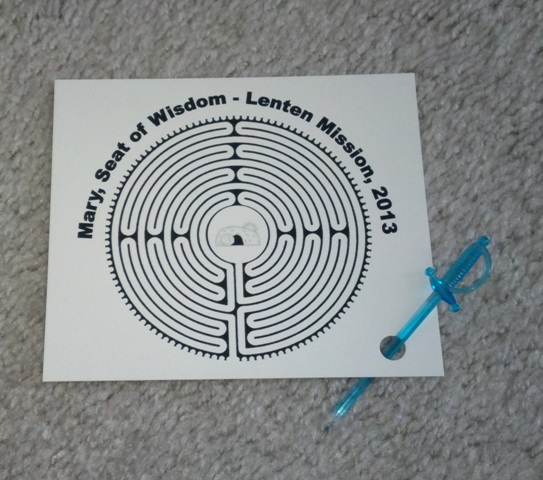This week, I have had the privilege of preaching a Lenten Family Mission at Mary, Seat of Wisdom parish in Park Ridge, IL, on the theme of the Mass (drawing from my book, Living the Mass). It has been an extraordinary experience of grace and I thank the good people of the parish for their strong turnout each evening of the Mission.
Last night, I focused on the Liturgy of the Word and how it invites us to follow “another way” – a way that leads us into the Kingdom of God. For the ritual action at the end of the talk, we symbolically walked this journey of faith by way of a labyrinth. A labyrinth, as you know, is a meditative spiral path that is walked slowly as one reflects on his or her own faith journey – a type of “pilgrimage’ that doesn’t involve airline tickets!
 Since the parish has no actual labyrinth (few do!), I created a hand-held labyrinth (see pic) which folks were able to use as a meditation tool, not all that different from fingering Rosary beads. These labyrinths are 3 1/2 by 4 inches, printed on a heavy stock with a semi-glossy finish. Around the labyrinth are the words “Mary, Seat of Wisdom Lenten Mission, 2013” and at the center of the labyrinth is an image of the empty tomb toward which we are journeying this Lent. I punched holes in the lower right corner of each card and inserted a plastic sword pick to use as a stylus for “walking” the labyrinth (the sword symbolizes the “Sword of the Holy Spirit” that St. Paul spoke of. As folks “walked” the labyrinth, the music minister sang Lead Me, Lord (John Becker, OCP), the refrain of which is perfectly suited for this meditative walk.
Since the parish has no actual labyrinth (few do!), I created a hand-held labyrinth (see pic) which folks were able to use as a meditation tool, not all that different from fingering Rosary beads. These labyrinths are 3 1/2 by 4 inches, printed on a heavy stock with a semi-glossy finish. Around the labyrinth are the words “Mary, Seat of Wisdom Lenten Mission, 2013” and at the center of the labyrinth is an image of the empty tomb toward which we are journeying this Lent. I punched holes in the lower right corner of each card and inserted a plastic sword pick to use as a stylus for “walking” the labyrinth (the sword symbolizes the “Sword of the Holy Spirit” that St. Paul spoke of. As folks “walked” the labyrinth, the music minister sang Lead Me, Lord (John Becker, OCP), the refrain of which is perfectly suited for this meditative walk.
Here is a Word file of the labyrinth design I created which you can manipulate for your own needs.
Here is the link to the sword picks which can also easily be found at most party stores. Likewise, here is a link to a pewter labyrinth that you may be interested in for your own use in meditation. It is mmodeled after the labyrinth in the Cathedral of Chartres in France.
Finally, here is what I say about labyrinths in my book Practice Makes Catholic:
It’s not unusual today for a retreat center to have an indoor or outdoor labyrinth. A labyrinth is a circular pattern, often with a cross at its center, and a person walks that pattern as a spiritual practice. The labyrinth might be a permanent outdoor structure made of stone and earth, or it could be a large patterned cloth that can be spread on the floor for walking and stored away when not in use. The purpose of walking a labyrinth is to engage one’s heart, mind, and body in a contemplative experience symbolic of our spiritual journey in life. The experience of walking the labyrinth can be thought of as a pilgrimage-in-place. Walking the labyrinth is an experience of solitude and it is done thoughtfully, at one’s own pace and in silence. While walking the path, one can meditate on a Scripture passage or on the stations of the cross or just use the time to engage in conversation with God. Christians need not be concerned that the labyrinth traces its roots to paganism since; the circle and the journey are so intrinsic to human nature that most cultures and religions have used them. Over the centuries, Catholics have transformed more than a few pagan customs into spiritual practices (e.g. celebrating the birth of Christ on December 25). It is precisely the goal of the Gospel to affirm those elements of culture that are in line with the Gospel and to purify and transform those that are not. However, we should also be wary of any new-age thinking that occasionally seeks to associate itself with the practice of walking the labyrinth.





Our (Episcopal) church has an outdoor labyrinth, also modeled on Chartres, but painted on brick in our fenced (unlocked) garden. It is quiet, surrounded by trees, and is often used by non-church-members as well. I have never tried a handheld labyrinth, but it sounds interesting and accessible. I sent a link to your blog to the gal who spearheaded the labyrinth’s recent repainting.
Thanks, Deborah…sounds very nice!